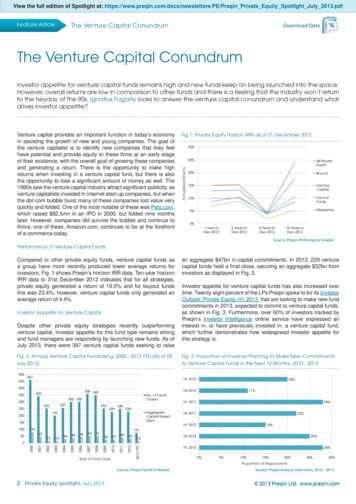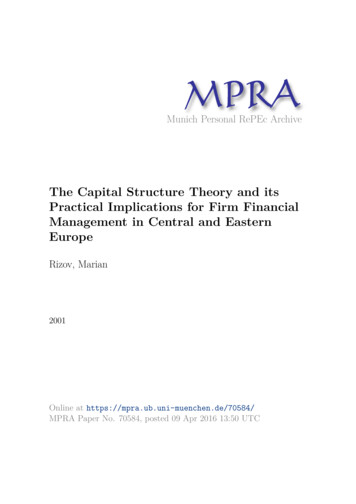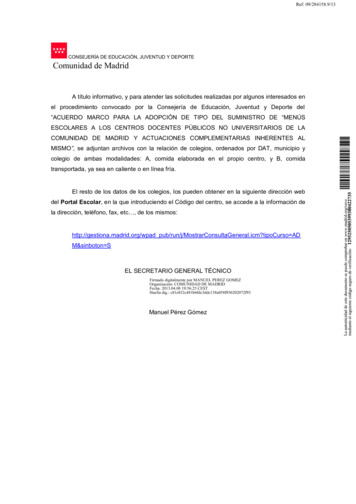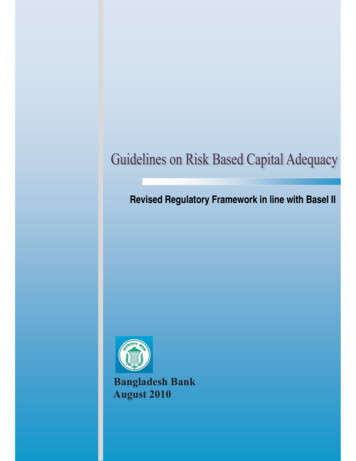
Transcription
Why are minimum capitalrequirements a concern forentrepreneurs?Minimum capital requirements significantly slow entrepreneurship.1 Such requirements also fail to serve their intended purpose of protecting consumers andcreditors from hastily established andpotentially insolvent firms. In recent yearsmany governments have stopped requiring new businesses to deposit minimumcapital in banks or with notaries beforethey can begin operations.What is a minimum capital requirement?It is the share capital that must be deposited by shareholders before starting business operations. For the Doing Businessstarting a business indicator the paid-inminimum capital is usually the amountthat an entrepreneur needs to deposit ina commercial bank or with a notary when,or shortly after, incorporating a business,even if the deposited amount can bewithdrawn soon after a company is created.2 In most cases this required amountis specified in an economy’s commercialcode or company law.3 Research showsthat the existence of a minimum capitalrequirement directly hinders business development and growth.4Of the 189 economies studied in Doing Business 2014, 99 have no minimumcapital requirements. Some economiesnever required firms to deposit moneyfor incorporation, while 39 have eliminated minimum capital requirements in thepast seven years. Armenia, Belarus, Bulgaria, Denmark, Kosovo, the Republic ofKorea, the Kyrgyz Republic and the United Kingdom are among these economiesthat have cut or eliminated such requirements. For instance, Belarus halved itsminimum capital requirement for privatelimited liability companies in 2008, thenabolished it a year later. In 2009 Bulgariareduced its minimum capital requirementby 99%, to less than 2. That same year,Denmark slashed its minimum capital requirement for limited liability companiesfrom about 22,000 to about 14,000.All of these changes lower the costs toentrepreneurs to operate in the formalsector. The other 90 economies still require entrepreneurs to deposit capital before registering a business. This amountvaries greatly—from 1 in Germany tomore than 58,000 in Myanmar.WHERE IS THE MINIMUMCAPITAL REQUIREMENT MOREPREVALENT?Across regions, minimum capital requirements are lowest in Europe and CentralAsia, Latin America and the Caribbeanand OECD high-income economies (figure 4.1). In Latin America and the Caribbean only 10 of 32 economies requirenew businesses to deposit minimumcapital, with the Dominican Republic imposing the most—almost half of incomeper capita, or about 2,500. Still, mostof the 10 economies that had enforcedcapital requirements keep them low. InSuriname it is about 30—0.4 percentof income per capita—and in Bolivia it is 40, equivalent to 1.8 percent of incomeper capita. And in the past 10 years othereconomies in the region, such as Mexico,St. Kitts and Nevis, and Uruguay, haveeliminated minimum capital requirements altogether.Among OECD high-income economies,Austria and Slovenia have the highestminimum capital requirements, askingentrepreneurs to commit more than 40%of gross national income per capita. InSub-Saharan Africa 13 economies haveminimum capital requirements exceeding200% of income per capita. An extremeexample is Niger, where the minimum Across regions, minimum capitalrequirements are lowest in Europeand Central Asia. Of the 189 economies studied inDoing Business 2014, 99 do not haveminimum capital requirements forfirms. Some economies have neverhad them, while 39 have eliminatedthem in the past seven years. Minimum capital requirementsare comparatively higher in lowincome economies. Paid-in minimum capital is oftena fixed amount that does not takeinto account firms’ economicactivities, size or risk related totheir activity. Higher minimum capitalrequirements are associated withless access to finance for small andmedium-size firms. Higher minimum capitalrequirements are associated withweaker regulations on minorityinvestor protections and tend toenable the informal economy.
DOING BUSINESS 2014compared with other regions. For instance, in 2012/13, Sri Lanka was the onlyeconomy of 8 in those studied that simplified business registration comparedwith 10 of 21 in Europe and Central Asia.5FIGURE 4.1 Minimum capital requirements by region150125.7100Sub-SaharanAfrica15.8Middle East &North Africa13.2South Asia10.4East Asia &Pacific3.6OECD highincome3.5Latin America &Caribbean0Minimum capital requirements are relatively higher in low-income economiesthan in lower-middle, upper-middle andhigh-income ones. Among high-incomeeconomies, 25% have a minimum capitalrequirement ranging from 1.5% to 230%of income per capita—from about 1,500in Malta to more than 50,000 in Bahrain.Bahrain and Oman require new limited liability companies to deposit the equivalentof more than 200% of income per capitain bank accounts to complete registrationand commence business operations.45.450Europe &Central Asiamin. cap. (% of GNI pc)42Note: Myanmar is excluded from the sample as it is a significant outlier.Source: Doing Business database. 14,000 to less than 2. Similarly, in 2013,Morocco eliminated its minimum capital requirement for limited liability companies. Many economies in Europe andCentral Asia and the OECD high-incomeregion have also sharply cut or eliminatedminimum capital requirements.capital requirement is equivalent to 528%of income per capita—about 2,000.Globally, except in South Asia, minimumcapital requirements have been cut overthe past seven years. The biggest changes have occurred in the Middle East andNorth Africa, where the share of economies with minimum capital requirementsof less than 5% of income per capita fellfrom over 60% in 2006 to 6% in 2013(figure 4.2). In 2011 Jordan reduced itsminimum capital requirement from aboutIn South Asia only India and Maldivesstill have minimum capital requirements.In India it is about 1,900; in Maldives, 135. In general, South Asia is lagging behind on business entry regulatory reformsFIGURE 4.2 Share of economies where the minimum capital requirement is less than 5%of income per capitaOECD high income(30 economies)Europe & Central Asia(22 economies)South Asia(8 economies)Middle East & North Africa(16 economies)Sub-Saharan Africa(45 economies)East Asia & Pacific(23 economies)Latin America & Caribbean(30 : The data sample for DB2006 (2005) includes 174 economies. The sample for DB2014 (2013) also includesThe Bahamas, Bahrain, Barbados, Brunei Darussalam, Cyprus, Kosovo, Liberia, Luxembourg, Malta, Montenegro,Qatar and San Marino, for a total of 185 economies. DB2006 data have been adjusted for data revisions andchanges in methodology and regional classifications of economies.Source: Doing Business database.Of the 34 low-income economies studied, 18 do not have minimum capital requirements. Among the other 16, 11 aremembers of the Organization for theHarmonization of Business Law in Africa,6 which has fixed the minimum capitalrequirement at about 2,000.DO MINIMUM CAPITALREQUIREMENTS FULFILL THEIRREGULATORY FUNCTIONS?The minimum capital requirement findsits roots in continental Europe of the 20thcentury.7 Back then, the minimum paidup capital was stipulated by law and itsprimary legislative purpose was to protect creditors and nurture confidence infinancial markets. Nowadays, despite thefinancial burden that minimum capitalrequirements impose on potential entrepreneurs, some argue that they protectinvestors and consumers from new firmsthat are set up carelessly, might not befinancially viable and will likely closesoon after launching. Advocates of thisargument claim that minimum capitalrequirements enable prospective investors to consider investments more cautiously.But this regulatory fix does not adequately address the problem. Paid-in minimumcapital is often a fixed amount that doesnot take into account firms’ economic activities, size or risks. In some cases it isthe same for different types of companiesas well. For instance, a small company
WHY ARE MINIMUM CAPITAL REQUIREMENTS A CONCERN FOR ENTREPRENEURS?in the services industry with low startup capital has to pay as much as a largemanufacturing company with high initialcapital in Gabon, despite the differencein business activity and size. Moreover,funds tied up in minimum capital requirements, particularly in economies wherethe amount is sizable, could impose financial constraints on companies thathave other needs, such as hiring, buyingequipment or developing services.8Others argue that minimum capital requirements shield firms from insolvencyand so protect creditors and investors.9But lenders tend to base their decisionson commercial risks rather than government-imposed minimum capital requirements.10 Creditors usually prefer to evaluate firms’ income statements, businessplans and other representative indicators.Thus, many economies have found other ways to protect investors, particularlywith limited liability companies. For instance, Hong Kong SAR, China outlinessolvency safeguards in its Companies Actand does not require a specific amountof paid-in minimum capital for businessincorporations. Furthermore, companieshave different probabilities of becominginsolvent. Even with a minimum capitalrequirement there is no guarantee that afirm would not face insolvency because ofother factors such as poor managementand decision making, bad business conditions and market changes.11If the enforced minimum capital requirement is too high, it might impede thedevelopment of start-ups. It could blockpotential entrepreneurs seeking to startbusinesses as alternatives to unemployment.12 In Ethiopia the official unemployment figure is more than 20%, yet theminimum capital requirement is 184% ofincome per capita. Though the minimumcapital requirement alone does not account for Ethiopia’s high unemployment,it does hamper the development of smalland medium-size formal businesses thatmight be a source of employment.13Some researchers also argue that highminimum capital requirements distorthealthy competition by putting at disadvantage entrepreneurs with less financial capacity.14 A firm is expected to useits financial resources to establish thebusiness and day-to-day operations. Sofreezing capital in a bank account mayundermine a company’s growth. In Bolivia and Ghana minimum capital can bewithdrawn in full only after a company’sdissolution. Moreover, high minimumcapital requirements can enable fraudulent activities that they are supposed toprevent. Entrepreneurs eager to incorporate companies but lacking the requiredfunds, often falsify company incorporation forms or withdraw funds soon afterincorporation.15If the capital requirement is too low, itfails to screen out potentially unviablebusinesses. A low requirement does littleto protect creditors if a company undergoes financial distress.16 In many economies the requirement is merely symbolicbecause governments and company registries cannot predetermine how muchmoney might be needed to cover companies’ liabilities if they become insolvent.17For example, France, Germany, Japan andJordan have minimum capital requirements of less than 5. In addition, a minimum capital requirement does not limitcompany debt because once the capitalamount has been established, there areusually no limits on the borrowing ofcompanies.18Minimum capital requirements are especially futile if funds can be withdrawn andpossibly used to cover expenses unrelated to the business soon after a companyis incorporated. For instance, in Estonia,Luxembourg and Thailand entrepreneurscan withdraw start-up capital immediately after incorporating a business—sominimum capital requirements provideno security to potential creditors.19A better way to make markets more efficient and protect creditors would beto enforce mandatory disclosure of information, such as mandatory filing ofannual financial accounts in companyregistries and enhancing the supervisoryrole of company registries. Other forms ofcreditor protection already exist in manyeconomies, including corporate governance monitoring, setting of interestrates and contractual provisions such asbond indentures and loan agreements.20The United States, for instance, once imposed significant requirements on howmuch capital had to be contributed andmaintained in a corporation. But thoserules have lost virtually all of their valuefor stockholders and creditors becausebetter approaches have been developed.Today creditors must rely primarily onnegotiated contractual protections, asstipulated in statutory and incorporationagreements.21A study of 5 EU economies shows thateliminating minimum capital requirements makes it easier to start small andmedium-size enterprises. The numberof registered businesses has increasedin 4 of the economies studied that havelowered or abolished minimum capitalrequirements (France, Germany, Hungaryand Poland). Research also shows that, inaddition to significantly increasing the total number of limited liability companies,such legal reforms have raised the number of new firms created.22Another study on the effects of deregulation of corporate laws on company incorporation shows that entrepreneurs havetaken advantage of recent rulings by theEuropean Court of Justice allowing themto select the economy where they incorporate regardless of their initial location.For instance, cross-country incorporationfrom businesses in other EU economiesincreased significantly in the United Kingdom, driven by low capital requirementsand start-up costs.23WHAT IS THE ECONOMICRELEVANCE OF MINIMUMCAPITAL REQUIREMENTS?Through the analysis of minimum capitalrequirements it is possible to identify 2main types of correlations: one relatingminimum capital requirements to othertypes of regulations and another relating minimum capital requirements witheconomic outcomes, such as the size ofthe informal economy. All the results presented here are based on correlations andcannot be interpreted as causal.The analysis shows that minimum capital requirements are related to 2 types ofregulations: insolvency laws and its implementation and minority shareholderprotection. The efficiency of insolvencylaws is measured by the Doing Businessrecovery rate indicator. The regressionanalysis suggests that minimum capital43
DOING BUSINESS 2014min. cap. (% of GNI pc)FIGURE 4.3 Higher minimum capital requirements are associated with weaker investorprotectionStrength of investor protection indexSource: Doing Business database.min. cap. (% of GNI pc)FIGURE 4.4 Higher minimum capital requirements are associated with less access tofinance for small and medium-size enterprisesShare of firms identifying access to finance as a major constraintSource: World Bank Enterprise Surveys, 2012.FIGURE 4.5 Higher minimum capital requirements are associated with more informalitymin. cap. (% of GNI pc)44Share of firms competing against informal sectorSource: World Bank Enterprise Surveys, 2012.requirements might not help creditors recover their investments. There is a strongnegative association between such requirements as measured as a percentageof an economy’s income per capita andthe recovery rate of creditors. The recovery rate for investors tends to be higherin economies that do not have minimumcapital requirements.24 So, indeed, suchrequirements do not play a crucial role insafeguarding creditors against companybankruptcies.The negative correlation between minimum capital requirements and thestrength of investor protection index(which measures legally required minority shareholder protections provided bylaw) is also significant (figure 4.3).25,26Economies that do not have minimumcapital requirements or set them very lowtend to better protect investors by beingmore likely to promote transparency incorporate transactions, provide easy access to corporate information and havestricter director liability standards.With regards to economic outcomes,the analysis shows that in economieswith high minimum capital requirements,small and medium-size firms have lessaccess to bank financing.27 The analysisalso reveals a strong correlation betweenthe amount of minimum capital requiredand the percentage of small and medium-size enterprises that cite accessto finance as a major constraint to theirbusiness operations (figure 4.4).Furthermore, there is a strong positiveassociation between minimum capital requirements and the percentageof firms in economies who say that theinformal economy severely constrainstheir growth (figure 4.5). If entry costsare prohibitively high, entrepreneursmight be disinclined to formalize theirbusinesses. There is also a strong negative relationship between the number ofyears that firms operate without formalregistration and the burden of minimumcapital requirements.28 Based on thisrelationship, higher minimum capitalrequirements are associated with longer periods when firms operate withoutformal licenses. The less money thatfirms have to spend on minimum capitalrequirements, the less likely they are tocompete against informal businesses as
WHY ARE MINIMUM CAPITAL REQUIREMENTS A CONCERN FOR ENTREPRENEURS?those firms have a greater incentive tobecome formally registered.There is also a strong negative associationbetween minimum capital requirementsand the number of new formal businesses.29 This result supports the argumentthat minimum capital requirements deterentrepreneurial activity, creating obstacles for business development.7. The German AktG of 1937 and the ItalianNOTESThis case study was written by Valentina Saltaneand Paula Garcia Serna.ma 2007.1. vanStel, Storey and Thurik (2007); Blanch-2.CONCLUSIONDespite its shortcomings, minimumcapital requirements remain a reality for many economies, especially inthe Middle East and North Africa andSub-Saharan Africa. But every year moreeconomies slash or eliminate how muchmoney entrepreneurs must deposit tostart businesses. Governments can takevarious other steps to protect investorsand creditors, minimize risks of bankruptcy and safeguard consumers frompotentially hazardous products.Civil Code of 1942.8. Chan 2009.9. Miola 2005.10. Djankov 2009; Ewang 2007; Alonso Ledes-3.4.5.6.flower, Oswald and Stutzer (2001); Klapperand Love (2011); Dreher and Gassebner(2011).The paid-in minimum capital measured bythe starting a business indicator representsthe amount an entrepreneur needs to deposit within 3 months of business incorporation.In the following sections it is referred to asminimum capital.For instance, in Belgium the requiredminimum capital is defined in the CompanyCode, in Ecuador in the Companies Act andin Togo in the Organisation pour l’Harmonisation en Afrique du Droit des Affaires(OHADA) Uniform Act on the GeneralCommercial Law.vanStel, Storey and Thurik (2007); Blanchflower, Oswald and Stutzer (2001).Belarus, Bulgaria, Kazakhstan, Kosovo,Lithuania, FYR Macedonia, Romania, Serbia,Ukraine and Uzbekistan.OHADA members are Benin, Burkina Faso,Cameroon, the Central African Republic,Chad, the Comoros, the Republic of Congo,Côte d’Ivoire, the Democratic Republic ofCongo, Gabon, Guinea, Guinea-Bissau, Mali,Niger, Senegal and Togo.11. Mülbert 2006.12. Hornuf and others 2011.13. World Development Indicators 2012 andDoing Business database.14. Chan 2009.15. Chan 2009.16. Miola 2005.17. Ewang 2007.18. Alonso Ledesma 2007.19. Miola 2005.20. Miola 2005.21. Booth 2005.22. Hornuf and others 2011.23. Becht, Mayer and Wagner 2008.24. The results are significant at the 5% levelafter controlling for income per capita.25. The strength of the investor protection indexis the average of the extent of the disclosureindex, the extent of the director liability indexand the ease of the shareholder suits index.The index ranges from 0 to 10, with highervalues indicating more investor protection.26. The results are significant at the 5% levelafter controlling for income per capita.27. The results are significant at the 5% levelafter controlling for income per capita.28. The results are significant at the 5% levelafter controlling for income per capita.29. The results are significant at the 5% levelafter controlling for income per capita.45
the same for different types of companies as well. For instance, a small company FIGURE 4.2 Share of economies where the minimum capital requirement is less than 5% of income per capita 56.5 44.4 6.3 75.0 23.8 30.0 80.6 73.9 51.1 62.5 87.5 85.7 50.0 0 20406080100 Latin America & Caribbean (30 economies) East Asia & Pacific (23 economies) Sub .










